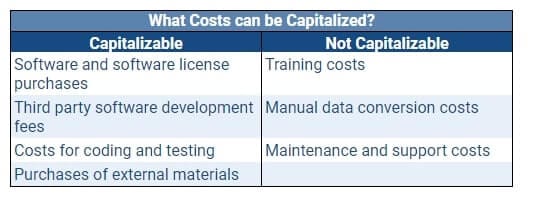FASB internal-use software standard
The increase in accounting and finance professionals working remotely has made cloud-based software solutions more attractive to businesses and organizations. Understanding FASB Subtopic ASC 350-40, Customer’s Accounting for Implementation Costs Incurred in a Cloud Computing Arrangement That Is a Service Contact (ASC 350-40) is critical for many professionals, as organizations are entering into cloud-based service contracts at a higher rate than ever before. Below, we highlight the basic concepts and application of ASC 350-40.
Effective date of ASC 350-40
ASC 350-40 was originally published in early 2015 to be effective beginning in 2016. During the comment period and continuing after 2016, stakeholders requested further clarification, so the FASB published an amendment to ASC 350-40 in 2018. The updates to ASC 350-40 are effective for public entities for fiscal years beginning after December 15, 2019, and interim periods of public entities within those fiscal years. Therefore, a public entity with a calendar year end adopted the amended ASC 350-40 as of January 1, 2020. For non-public entities, the amended ASC 350-40 is effective for annual reporting periods beginning after December 15, 2020.
The need for clarity
Accounting Standards Update 2018-15 Intangibles—Goodwill and Other—Internal-Use Software amended ASC 350-40 to provide more clarity and visibility to certain fees paid for cloud computing arrangements that do not include a license for use. As mentioned earlier, the need for cloud-based arrangements is increasing for all types of companies and organizations. However, prior to the updates to ASC 350-40, this created a challenge for entities, as the previous guidance did not adequately specify which costs associated with service agreements could be capitalized.
Capitalizable vs. non-capitalizable
Capitalizable is the accounting term to differentiate between costs allowed to be recorded to the balance sheet and costs that must be expensed in the period incurred. Typically entities look at capitalizable costs more favorably because recording them on the balance sheet allows for the cost to be recognized over the life of the capitalized asset instead of all at once. Allocating a cost over the life of the capitalized asset reduces the impact to net income for the period incurred. Due to the preferred treatment, capitalizable costs are specified in the accounting standards to provide consistency in financial reporting. One criteria considered is whether or not the cost provides a benefit to the organization over time.
Prior to the clarification, the accounting treatment was different for a contract which contained a software license vs. a service-only contract. Previous guidance specified that the cost of a software license and the related implementation costs could be capitalized. However, the expenses in a service contract were expensed as incurred and there was no discussion of the implementation costs attributable to the hosting agreement. Entities historically treated the expenses for these agreements the same, including any implementation costs. This confusion resulted in entities expensing the implementation costs for the service contract although certain implementation costs were capitalizable.
Before ASC 350-40, entities were not taking advantage of the capitalization rules for some types of software agreements because they were ambiguous. Companies were basing the decision to use on-premise software solutions vs. cloud-based software solutions on unclear accounting treatment, and not the operational impact to the business. As a result, incorrect accounting caused companies to view hosting agreements as a bigger impact to earnings than they often were, negating the positive technological aspects of moving to cloud-based computing. The adverse impact to companies’ operational decisions is another reason ASC 350-40 was issued. Now ASC 350-40 has a consistent and clear approach that entities can apply to account for hosting agreement fees.
Updates to ASC 350-40
From a customer’s perspective, if a cloud computing agreement includes a license for the use of software, the portion of the agreement for the software license and the related implementation fees are capitalizable. For agreements with no software license, the arrangement is considered a service contract and the updated guidance clarifies which implementation costs may be capitalized. In terms of the impact of the service contract to the financial statements, a prepaid asset is recognized on the balance sheet for the portion of the contract that can be capitalized. Any expenses incurred upfront are recognized in the period incurred. The portion of the contract for future payments is recorded as a liability if future payments are due.
Capitalization depends on the phase of the project in which the costs are incurred as well as the nature of the costs. Below is a description of the various phases of software development and implementation as well as the appropriate capitalization vs. expense treatment.
Preliminary project phase
The preliminary project phase is the period in which an entity determines the system requirements for the internal use software. Activities during this phase are similar to research and development expenses, and therefore, all costs during this stage should be expensed as incurred.
Application development phase
An entity enters the application development phase after it makes the decision to move forward with a software project and has express approval of management. During this stage, the entity will capitalize internal and external costs to develop or purchase internal-use software.
Generally, for internally developed software, only costs that relate to the actual development of the software are capitalizable. Capitalization of data conversion costs depends on the method in which the data is converted. If the data is converted using software, the cost to develop or purchase that specific software is capitalized as software development costs. However, manual data conversion processes should be expensed as incurred. Training costs and overhead costs, even if incurred during this phase, are also expensed as incurred.
Post-implementation phase
Once the software is ready to be used by the entity, the post-implementation phase begins. Costs incurred during this stage, such as training and maintenance, must also be expensed as incurred. Certain upgrade and enhancement costs incurred during this stage may be eligible for capitalization, if the costs meet the capitalization criteria of the application development stage.
Upgrades and enhancements
Costs incurred in this phase include changes to the software that go beyond routine maintenance. If the improvements result in additional functionality, they fall into the upgrades and enhancements category and the costs incurred can be capitalized. Work on the software that does not result in additional functionality is looked at as routine maintenance costs and must be expensed as incurred.
Capitalizable vs. non-capitalizable software costs
Capitalizable costs
The capitalizable costs for a software agreement are the payments attributable to the purchase and installation of the software license. Generally, the fees that fall into this category are part of the implementation costs. This includes, but is not limited to:
- Software and software license purchases
- Third party software development fees
- Costs for coding and testing, directly related to the software
- Purchases of external materials, directly related to the software
Non-capitalizable costs
On the other hand, costs that cannot be capitalized are, in general terms, ongoing software costs after implementation. Specifically, fees related to the usage or maintenance of the software are non-capitalizable. These costs should be expensed as they are incurred. This includes, but is not limited to:
- Training fees
- Manual data conversion costs
- Maintenance and support costs
This table provides a summary of the treatment of costs for cloud-based software:

Initial measurement and subsequent measurement
Initial measurement
For a cloud computing arrangement, a prepaid asset is recognized for the total amount of costs determined to be capitalizable. Any expenses incurred upfront are recognized in the period incurred. Then, to the extent there are payments still attributable to the implementation and other capitalizable costs, a liability is also recognized. The liability is recorded for future payments owed under the agreement and the asset is recorded at total applicable contractual cost, with any difference representing payments made at the inception of the contract.
Subsequent measurement
The intangible asset is amortized over the life of the cloud computing arrangement. Most commonly, straight-line amortization of the intangible asset is used. However, instances could exist where a different method is more appropriate. As long as the basis for amortization is systematic and rational and reflects the usage of the asset, it may be employed. The journal entry to amortize the prepaid asset is a debit to the cloud computing arrangement expense line item and a credit to the asset. The liability is relieved as payments are made.
Internal-use software under ASC 350-40: An example
In our example below, we specify which costs are capitalized vs. expensed as incurred for Company XYZ for a cloud computing arrangement.
Company XYZ enters into a cloud computing arrangement with Vendor ABC. This application will allow certain employees at Company XYZ to view employee contact information in one central online location. The agreement does not include a license to use any software. Company XYZ also elects to have Vendor ABC provide a customized interface for the employees at Company XYZ to use the application.
The capitalization of costs depends on the nature of the costs and the phase of development in which the costs are incurred. Specific details of the work performed and the costs incurred in each phase of the project is described below. The explanation of each phase is followed by a determination of whether the fees are capitalizable.
Preliminary project phase
Company XYZ hires a consultant to assist with the preliminary selection of a software. Also, the management team at Company XYZ creates a committee to help with determining the list of the requirements and functionality needed for the software solution.
Which of the costs incurred in this stage are capitalizable?
- Costs associated with the creation of the committee to determine the system requirements and performance requirements are expensed in the period incurred.
- Compensation for the consultant to assist with the selection of the software are expensed in the period incurred.
Application development phase
Company XYZ ultimately chooses to use the cloud computing application provided by Vendor ABC. To begin development of the new application, Company XYZ authorizes a team of internal software developers to create a software to convert old data from the existing system to the new system. Company XYZ also incurs costs to manually purge existing data from the current system (i.e., perform reconciliations and remove outdated data). Additionally, Company XYZ hires consultants from Vendor ABC from out of state to train applicable employees in the use of the new application.
Which of the costs incurred in this stage are capitalizable?
- The portion of the salaries attributable to the internal developers’ time to develop software to help with the conversion of old data to new data in the system are capitalizable.
- Costs for the manual purging and reconciling of data to prepare for data conversion is expensed in the period incurred.
- The consultation fees and travel expenses for the training of employees on the usage of the new application are expensed in the period incurred.
Post-implementation phase
Company XYZ implements the software and, after transition, incurs costs for additional training of employees. Additionally, Company XYZ enters into a maintenance and customer support contract with Vendor XYZ for the next year.
Which of the costs incurred in this stage are capitalizable?
- Costs for additional training after implementation are expensed in the period incurred.
- Monthly fees for the maintenance and customer support contract are expensed in the period incurred.
Upgrades and enhancements
After employees are trained and onboarded with the new application, Company XYZ continues to incur its ongoing software maintenance and customer support costs. However, after a few months of use the management team decides to allocate resources for the internal software development team to provide an upgraded user interface for the employees at Company XYZ. Please note this upgraded interface will enhance the functionality of the software.
Which of the costs incurred in this stage are capitalizable?
- Monthly fees for the maintenance and customer support contract are expensed in the period incurred.
- The portion of the salaries attributable to the internal developers’ time to develop the upgraded user interface and enhanced functionality are capitalizable.
Summary
This article provides a summary and example of accounting for cloud computing arrangements under ASC 350-40. Specifically, the article covered in depth which costs are capitalized vs. expensed as incurred for cloud computing arrangements. The issuance of updates to ASC 350-40 in 2018 provided much needed clarity to entities in regard to the accounting treatment for cloud computing arrangements. This clarification was necessary, considering the higher rate at which entities are reviewing and entering into cloud computing agreements and also considering the fact many employees are working remotely prompting additional need for cloud computing capabilities.





